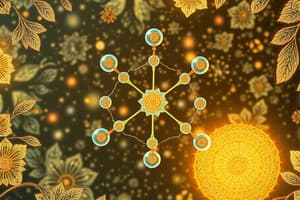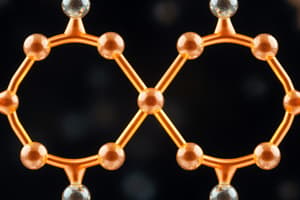Podcast
Questions and Answers
In the formation of ionic compounds, what fundamental process leads to the creation of ions?
In the formation of ionic compounds, what fundamental process leads to the creation of ions?
- The creation of electrons from energy.
- The transfer of electrons between atoms. (correct)
- The merging of atomic nuclei.
- The sharing of protons between atoms.
During the formation of NaCl, sodium (Na) becomes Na+ and chlorine (Cl) becomes Cl-. What force holds these ions together in the NaCl compound?
During the formation of NaCl, sodium (Na) becomes Na+ and chlorine (Cl) becomes Cl-. What force holds these ions together in the NaCl compound?
- Nuclear force
- Magnetic force
- Electrostatic attraction (correct)
- Gravitational force
Magnesium oxide (MgO) is formed when magnesium (Mg) transfers two electrons to oxygen (O). What are the resulting charges on the magnesium and oxygen ions, respectively?
Magnesium oxide (MgO) is formed when magnesium (Mg) transfers two electrons to oxygen (O). What are the resulting charges on the magnesium and oxygen ions, respectively?
- Mg- and O+
- Mg2- and O2+
- Mg2+ and O2- (correct)
- Mg+ and O-
In the formation of calcium chloride (CaCl2), how many chloride ions (Cl-) are formed for each calcium ion (Ca2+)?
In the formation of calcium chloride (CaCl2), how many chloride ions (Cl-) are formed for each calcium ion (Ca2+)?
Why do ionic compounds typically have an overall neutral charge?
Why do ionic compounds typically have an overall neutral charge?
What type of attraction defines an ionic bond?
What type of attraction defines an ionic bond?
When an element forms an ion with a 2+ charge, what has occurred?
When an element forms an ion with a 2+ charge, what has occurred?
If element X loses one electron and element Y gains that electron, which of the following is true regarding the charges of the resulting ions?
If element X loses one electron and element Y gains that electron, which of the following is true regarding the charges of the resulting ions?
Which of the following is a crucial requirement for the formation of a stable ionic compound?
Which of the following is a crucial requirement for the formation of a stable ionic compound?
In which scenario would an ionic bond most likely form?
In which scenario would an ionic bond most likely form?
Flashcards
How are ions formed?
How are ions formed?
Ions are created when atoms lose or gain...
Sodium (Na) ion formation
Sodium (Na) ion formation
Atom that loses one electron to form a positively charged ion (Na+).
Chloride (Cl) ion formation
Chloride (Cl) ion formation
Atom that gains one electron to form a negatively charged ion (Cl-).
What is an ionic bond?
What is an ionic bond?
Signup and view all the flashcards
What is an ionic compound?
What is an ionic compound?
Signup and view all the flashcards
MgO Formation
MgO Formation
Signup and view all the flashcards
CaCl2 Formation
CaCl2 Formation
Signup and view all the flashcards
Charge of Ionic Compounds
Charge of Ionic Compounds
Signup and view all the flashcards
Study Notes
- Ions are formed through electron loss or gain.
- Electrons aren't created or destroyed, but transferred between atoms.
Example of NaCl Formation
- Sodium (Na) loses one electron, forming a Na+ ion.
- Chlorine (Cl) gains the electron from Na, forming a Cl- ion.
- The resulting Na+ and Cl- ions attract each other due to opposite charges creating an ionic bond.
- Sodium chloride (NaCl) is an ionic compound held together by ionic bonds.
Example of MgO Formation
- Magnesium (Mg) transfers two valence electrons to Oxygen (O), creating Mg2+ and O2- ions.
- The resulting Mg2+ and O2- ions attract one another via an ionic bond.
Example of CaCl2 Formation
- Calcium (Ca) loses two electrons, becoming a Ca2+ ion.
- Two Chlorine (Cl) atoms each gain one electron, becoming two Cl- ions.
- The Ca2+ ion is electrostatically attracted to both Cl- ions, balancing the charges.
Key Principles of Ionic Bond Formation
- Ionic compounds are neutral overall due to balanced charges.
- An ionic bond arises from electrostatic attraction between oppositely charged ions.
- Achieving overall charge neutrality is essential when forming an ionic compound.
Studying That Suits You
Use AI to generate personalized quizzes and flashcards to suit your learning preferences.




